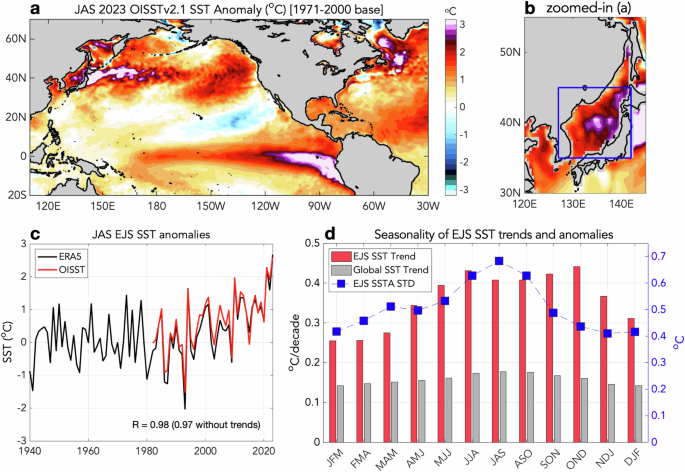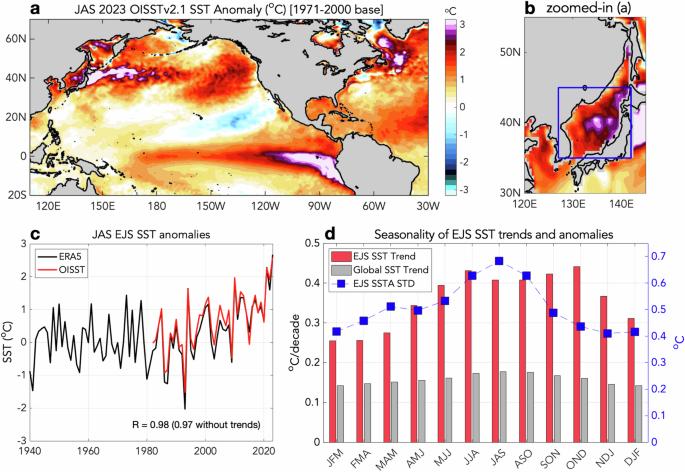夏季东海/日本海表面温度事件的可预测性和预测技能
IF 8.5
1区 地球科学
Q1 METEOROLOGY & ATMOSPHERIC SCIENCES
引用次数: 0
摘要
东/日本海(EJS)是西北太平洋的边缘海,是过去几十年来变暖最迅速、海洋热浪增加最严重的海区之一。鉴于影响渔业的海洋温度事件日益严重,并强化了东亚雨季等气候条件,进而影响到东亚邻近的人口密集地区,因此对夏季日本海变化的可预测性和熟练预测至关重要。我们利用观测资料和地球物理流体力学实验室(GFDL)的预测与地球系统研究无缝系统(SPEAR)季节预报系统来研究夏季东亚海洋温度(SST)的可预测性和预测技能。观测结果和季节预报系统显示,夏季江汉海面温度与前一年冬季海气耦合密切相关,可提前 8-9 个月预报。SPEAR 季节预报系统对从夏季到深秋的 EJS SST 事件进行了娴熟的预报,并对冬季初始化的长周期预报增加了娴熟度。我们发现,与巴伦支海变率有关的冬季大尺度大气环流可在东海上空引起持续的表面风异常和相应的向北埃克曼热输送。前几个季节进入 EJS 的海洋对流异常与瞬时大气胁迫一起,似乎在夏季异常 SST 的形成过程中发挥了作用,成为长期可预测性的来源。我们的发现为理解和预测东亚边缘海的季节变化提供了大尺度海洋-大气相互作用的潜在应用。本文章由计算机程序翻译,如有差异,请以英文原文为准。


Predictability and prediction skill of summertime East/Japan Sea surface temperature events
The East/Japan Sea (EJS), a marginal sea of the Northwestern Pacific, is one of the ocean regions showing the most rapid warming and greatest increases in ocean heatwaves over the last several decades. Predictability and skillful prediction of the summer season EJS variability are crucial, given the increasing severity of ocean temperature events impacting fisheries and reinforcing climate conditions like the East Asian rainy season, which in turn affects adjacent high-population density areas over East Asia. We use observations and the Geophysical Fluid Dynamics Laboratory (GFDL) Seamless System for Prediction and Earth System Research (SPEAR) seasonal forecast system to investigate the summertime EJS Sea Surface Temperature (SST) predictability and prediction skill. The observations and seasonal prediction system show that the summer season EJS SST can be closely linked to the previous winter air-sea coupling and predictable 8–9 months in advance. The SPEAR seasonal prediction system demonstrates skillful forecast of EJS SST events from summer to late fall, with added skill for long-lead forecasts initialized in winter. We find that winter large-scale atmospheric circulations linked to Barents Sea variability can induce persistent surface wind anomalies and corresponding northward Ekman heat transport over the East China Sea. The ocean advection anomalies that enter the EJS in prior seasons appear to play a role in developing anomalous SST during summer, along with instantaneous atmospheric forcing, as the source of long-lead predictability. Our findings provide potential applications of large-scale ocean-atmosphere interactions in understanding and predicting seasonal variability of East Asian marginal seas.
求助全文
通过发布文献求助,成功后即可免费获取论文全文。
去求助
来源期刊

npj Climate and Atmospheric Science
Earth and Planetary Sciences-Atmospheric Science
CiteScore
8.80
自引率
3.30%
发文量
87
审稿时长
21 weeks
期刊介绍:
npj Climate and Atmospheric Science is an open-access journal encompassing the relevant physical, chemical, and biological aspects of atmospheric and climate science. The journal places particular emphasis on regional studies that unveil new insights into specific localities, including examinations of local atmospheric composition, such as aerosols.
The range of topics covered by the journal includes climate dynamics, climate variability, weather and climate prediction, climate change, ocean dynamics, weather extremes, air pollution, atmospheric chemistry (including aerosols), the hydrological cycle, and atmosphere–ocean and atmosphere–land interactions. The journal welcomes studies employing a diverse array of methods, including numerical and statistical modeling, the development and application of in situ observational techniques, remote sensing, and the development or evaluation of new reanalyses.
 求助内容:
求助内容: 应助结果提醒方式:
应助结果提醒方式:


